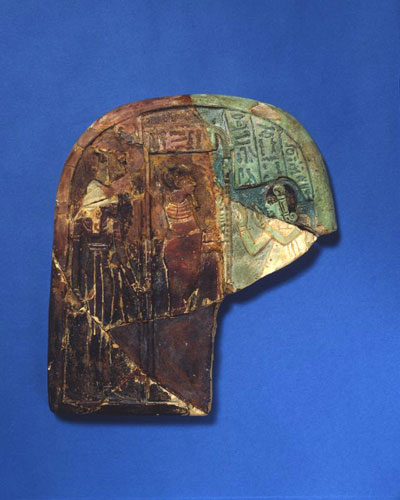
Among the unpublished finds of the University Museum’s excavations at ancient Memphis in 1915-1923 is the faience stela shown here. It bears the Museum registration number E 13578 and measures 22cm. by 25cm. It was originally covered with a light blue-green glaze, which is still preserved in the upper right portion. Elsewhere the glaze has either disappeared or has undergone a chemical change, its vitreous sheen having vanished and the color having changed to a red-black.
The scene represents a man, wearing a garb of a vizier of the New Kingdom, adoring two deities, the god Ptah, who stands beneath his canopy, and the goddess Maat (Justice), who stands behind the canopy. A three line inscription records the titles and name of the dedicator of the stela as “the prince and count, the god’s father beloved of the god, the sem-priest, the high priest of Ptah, the governor of Thebes and vizier, Khaemwas.” The god Ptah is identified in a one line caption as “Ptah, the Great One South of His Wall, the Lord of Ankh-towe [Memphis].” Of the caption of Maat, only the name remains. The vizier Khaemwas lived, according to the evidence of the contemporary papyri, during the reign of King Rameses IX of the 19th Dynasty (ca. 1138-1119 B.C.).
Faience was a favorite material of the Egyptians for all sorts of small objects, including amulets, beads, rings, scarabs, and shawabti figures. Stelae in faience, however, are comparatively rare. In a short period of research, I have found only ten published examples in the museums of Europe, although certainly others must also exist. The University Museum possesses two of them, that of Khaemwas, the vizier and high priest of Ptah, and a second discovered in the course of the 1929-1934 excavations at the Nubian site of Anibeh. This latter stela (E 14232), was on display in the Upper Egyptian Galleries, was published by G. Steindorff (Aniba, Vol. II, text p.67, plate 37b). It was dedicated to “the Chantress of Amun, Tanedjmet” by “her brother, who causes her name to live, the Count, Hor-nakht.”
